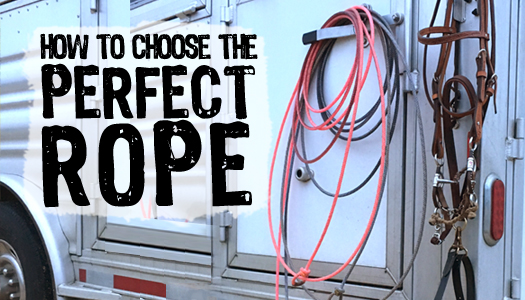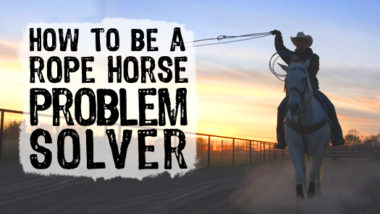Listen to this article in audio form! It’s #2 in the Team Roping Tips Podcast.
For the latest episodes subscribe on iTunes or your favorite podcast app.
How often have you been in the practice pen or at competition and gone through every rope in your entire bag, and still couldn’t find the perfect one?
Maybe you’re like me, and will drag every one out of your rope bag to swing and evaluate for a certain feel.
There are numerous factors that can contribute to the way our ropes feel. The rope industry had made some big strides with new technology over the past few years, but it still comes down to what works for you. Today I’d like to share a few ideas to consider for selecting a rope that will work best for you.
TYPES OF ROPES
Knowing rope composition is a large factor for me when selecting the rope I want to use on any specific day.
I carry two types of ropes in my rope bag. The first is a straight nylon and the other is a nylon/poly blend. I use Cactus Ropes and have for over 15 years now exclusively. Currently I use the C4 which is a 100% nylon rope and the Xplosion which is a nylon/poly blend.
Ropes develop a “memory” when they are manufactured. Have you ever stretched a piece of nylon cord and watched it shrink back to its original size? This is because nylon has an elastic property and reverts back to what is was before it was stretched. Straight nylon ropes are usually more consistent in their feel especially it warmer temperatures.
Adding poly blends to ropes provide “body” and weight to a rope that is helpful in situations like roping steers with large horns where you want your loop a little more open Poly is not as forgiving when it comes to its elastic properties. In fact it basically has no stretch. In colder temperatures poly blends can provide a little more consistent feel.
DIAMETER OF ROPE
Another factor I consider when deciding which rope to use is the diameter. I usually choose ropes that are in the small to medium range. One benefit to me for smaller diameter ropes is that they allow me to ensure I can have a comfortable grip on my reins while also holding the coils in my left hand.
ROPE LAY
I have used the full spectrum of rope lays throughout my career as both as a heeler and header. When I’m heading I want a rope that is going to close fast around the horns, yet still allow me to keep my loop open.
I primarily use and extra soft (XS) but will occasionally use a soft (S) depending on the type of steers I am roping. As a heeler I would recommend a medium soft (MS) or medium (M) lay on small fresh steers that have a lot of action. Just like heading, we want our loop to close up fast around the feet and a softer rope will allow that to happen.
If the steers have been roped more and are slower hopping I would want to use a rope with a lot more body and a little bit stiffer in lay. These lays are generally the hard medium (HM) or medium hard (MH).
STEER EVALUATION
At every event I attend, the first thing I do is evaluate the steers. Are they fresh steers or older steers? What is the variation in horn size? Etc.
On fresh steers or steers with smaller horns I like a rope that is fast, light, and generally a softer lay. Usually a straight nylon works best since your loop will close faster and is very forgiving.
On older steers or steers with larger horns I would suggest a nylon/poly blend. We need our loop to stay open a little longer through our delivery and the poly blend will allow the body of the rope to assist you with that. I may use a little stiffer lay on steers with large horns.
BREAK IN / LONG-TERM CARE
I personally like to rope of the dummy before I break in a rope on live steers. I may do this on foot roping my Bones roping dummy or horseback roping the Heel-O-Matic. During this time I adjust the coil and loop size to my preference. I will then tie the rope up and put it in my rope bag until I’m ready to rope live steers with it.
When I finally break a rope in on live steers I will rope approximately 10 head with it. I want to get some good stretches on it and also a little bit of rubber. I will then put it back in my rope bag until competition day.
This will allow the rope to use its “memory” and return as close as possible to its original state. Sometimes before a competition I will take my rope out of my bag and tie it to a post to give it a good stretch. This will open the gaps between the crowns and allow the lay of the rope to feel more like it did when it was new.
It is also important to know when to retire a rope. Look for spots in the rope where you dally – a majority of the time the area will have excess rubber or slick spots. You may even get kinks in your coils. Using worn out ropes is not worth the safety risk.
MY CONCLUSION
Don’t be afraid to experiment with different lays, rope sizes, or compositions of ropes to find out what works best. It’s all about what feels right to you.
As I mentioned my rope of choice is the Cactus Ropes Xplosion. I typically use this in an XS or S lay. Even though it’s a nylon/poly blend it has really been a consistent feel no matter when I lived in Wyoming in the cold winters or here in Texas now in the hot summers.
The Xplosion has a fast, snappy feel but with a little body and really allows me to feel the tip of my rope. I feel as though the overall durability and balance of the rope is well above any other rope on the market.
To learn even more about what Cactus Ropes has to offer, visit www.CactusRopes.com.

